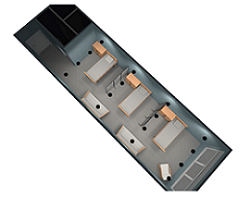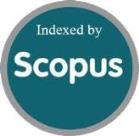Lighting Design for Visual Comfort and Energy Efficiency Considerations: A Patient Room Case Study
DOI:
https://doi.org/10.46604/ijeti.2024.13781Keywords:
artificial illumination, visual comfort, energy saving, LED, medical careAbstract
Discomfort glare causes unease and distraction, significantly affecting patients, staff, and visitors. Achieving visual comfort is essential for glare reduction, as it is primarily influenced by artificial lighting in the workplace. This study examines the probability of visual comfort and the unified glare rating (UGR) as measures of discomfort glare. UGR calculations compare three types of artificial lighting sources in a hospital patient room, considering both visual comfort and energy efficiency. This study analyzes different lighting installations with a focus on surface properties and their relative height as critical factors for enhancing visuals and reducing energy consumption. The results show that increasing the reflection coefficient can reduce energy consumption while improving visual comfort. Although LED lighting generally outperforms traditional lamps, the latter can still achieve significant performance improvements with increased surface reflectance.
References
Z. Kong, Q. Liu, X. Li, K. Hou, and Q. Xing, “Indoor Lighting Effects on Subjective Impressions and Mood States: A Critical Review,” Building and Environment, vol. 224, article no. 109591, 2022.
M. Mahdavinejad, H. Bazazzadeh, F. Mehrvarz, U. Berardi, T. Nasr, S. Pourbagher, et al., “The Impact of Facade Geometry on Visual Comfort and Energy Consumption in an Office Building in Different Climates,” Energy Reports, vol. 11, pp. 1-17, 2024.
N. Makaremi, S. Schiavoni, A. L. Pisello, and F. Cotana, “Effects of Surface Reflectance and Lighting Design Strategies on Energy Consumption and Visual Comfort,” Indoor and Built Environment, vol. 28, no. 4, pp. 552-563, 2019.
K. Hassouneh, A. Al-Salaymeh, and J. Qoussous, “Energy Audit, an Approach to Apply the Concept of Green Building for a Building in Jordan,” Sustainable Cities and Society, vol. 14, pp. 456-462, 2015.
N. S. A. Mahmoud, G. El Samanoudy, and C. Jung, “Simulating the Natural Lighting for a Physical and Mental Well-Being in Residential Building in Dubai, UAE,” Ain Shams Engineering Journal, vol. 14, no. 1, article no. 101810, 2023.
F. Salata, I. Golasi, M. Di Salvatore, and A. de Lieto Vollaro, “Energy and Reliability Optimization of a System That Combines Daylighting and Artificial Sources. A Case Study Carried Out in Academic Buildings,” Applied Energy, vol. 169, pp. 250-266, 2016.
I. Petrinska, D. Ivanov, and V. Georgiev, “Influence of the Light Distribution of Luminaires and the Room Surfaces’ Reflectance on the Illumination Levels, Uniformity and Glare in Indoor Lighting Systems,” Lux Junior 2019: 14. Internationales Forum Für Den Lichttechnischen Nachwuchs, pp. 63-70, 2019.
H. Jafarian, C. M. Demers, P. Blanchet, and V. Laundry, “Effects of Interior Wood Finishes on the Lighting Ambiance and Materiality of Architectural Spaces,” Indoor and Built Environment, vol. 27, no. 6, pp. 786-804, 2018.
A. Michael, C. Heracleous, S. Thravalou, and M. Philokyprou, “Lighting Performance of Urban Vernacular Architecture in the East-Mediterranean Area: Field Study and Simulation Analysis,” Indoor and Built Environment, vol. 26, no. 4, pp. 471-487, 2017.
N. Makaremi, S. Schiavoni, A. L. Pisello, F. Asdrubali, and F. Cotana, “Quantifying the Effects of Interior Surface Reflectance on Indoor Lighting,” Energy Procedia, vol. 134, pp. 306-316, 2017.
G. Lowry, “Energy Saving Claims for Lighting Controls in Commercial Buildings,” Energy and Buildings, vol. 133, pp. 489-497, 2016.
A. Gatea, M. F. Mohideen Batcha, and J. Taweekun, “Energy Efficiency and Thermal Comfort in Hospital Buildings: A Review,” International Journal of Integrated Engineering, vol. 12, no. 3, pp. 33-41, 2020.
K. B. de Oliveira, E. F. dos Santos, A. F. Neto, V. H. de Mello Santos, and O. J. de Oliveira, “Guidelines for Efficient and Sustainable Energy Management in Hospital Buildings,” Journal of Cleaner Production, vol. 329, article no. 129644, 2021.
S. Alzubaidi and P. K. Soori, “Energy Efficient Lighting System Design for Hospitals Diagnostic and Treatment Room—A Case Study,” Journal of Light & Visual Environment, vol. 36, no. 1, pp. 23-31, 2012. (In Japanese)
Discomfort Glare in Interior Lighting, CIE 117-1995, 1995.
C. Funke and C. Schierz, “Extension of the Unified Glare Rating Formula for Non-Uniform LED Luminaires,” Lux Junior 2015: 12. Internationales Forum Für Den Lichttechnischen Nachwuchs, pp. 80-81, 2015.
SLL Lighting Handbook, CIBSE, 2009.
F. B. Ismail, M. F. Izzuan, A. Abdulwahab, H. A. Kazem, and M. A. A. Rahmat, “Design and Development of Natural Lighting System in Modern Malaysian Building,” Construction Technologies and Architecture, vol. 12, pp. 97-110, 2024.
A. Peña-García and F. Salata, “The Perspective of Total Lighting as a Key Factor to Increase the Sustainability of Strategic Activities,” Sustainability, vol. 12, no. 7, article no. 2751, 2020.
P. Johnston, “Helpful Hues: The Role of Color in Health Care Lighting,” Health Facilities Management, vol. 24, no. 9, pp. 30-33, 2011.
R. A. González-Lezcano, Health and Well-Being Considerations in the Design of Indoor Environments, Hershey, PA: Engineering Science Reference, an imprint of IGI Global, pp. 243-258, 2021.
K. Van Den Wymelenberg and M. Inanici, “A Critical Investigation of Common Lighting Design Metrics for Predicting Human Visual Comfort in Offices with Daylight,” Leukos, vol. 10, no. 3, pp. 145-164, 2014.
D. H. Li and E. K. Tsang, “An Analysis of Daylighting Performance for Office Buildings in Hong Kong,” Building and Environment, vol. 43, no. 9, pp. 1446-1458, 2008.
S. Carlucci, F. Causone, F. De Rosa, and L. Pagliano, “A Review of Indices for Assessing Visual Comfort with a View to Their Use in Optimization Processes to Support Building Integrated Design,” Renewable and Sustainable Energy Reviews, vol. 47, pp. 1016-1033, 2015.
E. O. Oluoch, “Effect of Occupational Safety and Health Programmes on Employee Performance at Kenya Power Company Limited,” Ph.D. dissertation, Department of Business Administration, University of Nairobi, Nairobi, Kenya, 2015.
C. E. Ochoa, M. B. Aries, E. J. Van Loenen, and J. L. Hensen, “Considerations on Design Optimization Criteria for Windows Providing Low Energy Consumption and High Visual Comfort,” Applied Energy, vol. 95, pp. 238-245, 2012.
M. L. Eble-Hankins and C. E. Waters, “Subjective Impression of Discomfort Glare from Sources of Non-Uniform Luminance,” Leukos, vol. 6, no. 1, pp. 51-77, 2009.
M. Valentová, M. Quicheron, and P. Bertoldi, “LED Projects and Economic Test Cases in Europe,” International Journal of Green Energy, vol. 12, no. 8, pp. 843-851, 2015.
E. Dolat, M. Darjazipour, S. Sazgarnia, and A. Sazgarnia, “Light Spectrum of Compact Fluorescent Lamps in Iranian Market and Possibility of Hydroxyl Radical Production,” Journal of Mazandaran University of Medical Sciences, vol. 27, no. 152, pp. 165-174, 2017.
G. Ciampi, A. Rosato, M. Scorpio, and S. Sibilio, “Retrofitting Solutions for Energy Saving in a Historical Building Lighting System,” Energy Procedia, vol. 78, pp. 2669-2674, 2015.

Published
How to Cite
Issue
Section
License
Copyright (c) 2025 Samaneh Aghajari, Cheng-Chen Chen

This work is licensed under a Creative Commons Attribution-NonCommercial 4.0 International License.
Copyright Notice
Submission of a manuscript implies: that the work described has not been published before that it is not under consideration for publication elsewhere; that if and when the manuscript is accepted for publication. Authors can retain copyright in their articles with no restrictions. Also, author can post the final, peer-reviewed manuscript version (postprint) to any repository or website.

Since Jan. 01, 2019, IJETI will publish new articles with Creative Commons Attribution Non-Commercial License, under Creative Commons Attribution Non-Commercial 4.0 International (CC BY-NC 4.0) License.
The Creative Commons Attribution Non-Commercial (CC-BY-NC) License permits use, distribution and reproduction in any medium, provided the original work is properly cited and is not used for commercial purposes.







.jpg)


